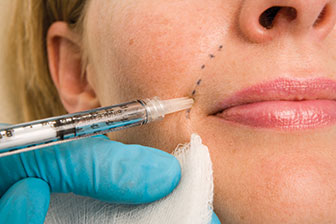Filling in Wrinkles Safely
On this page:
- What are Dermal Fillers, and How are They Used?
- What are the Risks?
- Tips for Consumers
- What About Botox?
In the quest for youth—or at least a more youthful appearance—women and men are seeking treatments to minimize laugh lines, crow's feet, and frown lines, as well as to plump up lips and cheeks. A popular treatment involves injecting dermal fillers into the face. In studies of FDA-approved dermal fillers, people generally report they are satisfied with the outcome of their treatments.
They are highly satisfied with the ability of these medical devices to improve the appearance of wrinkles or facial features (e.g., lips or cheeks) and restore a youthful appearance.
But Food and Drug Administration (FDA) medical officer Janette Alexander, M.D., advises that it’s important to know the risks before having the treatment.
What are Dermal Fillers, and How are They Used?
Injectable dermal fillers are soft tissue and wrinkle fillers approved by FDA as medical devices. Generally, these products are injected into the skin to help fill in facial wrinkles, restoring a smoother appearance. In addition, fat taken from other body areas is often used with the same goals. Alexander says that most of the fillers achieve a smoothing or filling effect, which lasts for about six months or longer in most people.
FDA has approved only one permanent wrinkle filler, which contains the polymethylmethacrylate beads. These are tiny round, smooth, biocompatible plastic particles that are not absorbed by the body. The filler is FDA-approved only for correcting facial tissue around the mouth.
In addition, FDA has approved a number of injectable dermal fillers that are temporary because the body eventually absorbs them. These products are used for correcting soft tissue defects in the face, such as moderate to severe facial wrinkles and skin folds, lip and cheek augmentation, and to restore or correct the signs of facial fat loss in people with human immunodeficiency virus (HIV). Not all products have been approved for the indications mentioned above. Please refer to the FDA’s list of approved dermal fillers for more information on a specific dermal filler.
These temporary fillers include the following materials:
- Collagen injections, made of highly purified cow or human collagen
- Hyaluronic acid gel, a protective lubricating gel, produced naturally by the body
- Calcium hydroxylapatite, a mineral and a major component of bone
- Poly-L-lactic acid (PLLA), a biodegradable, biocompatible, synthetic material
FDA has not approved dermal fillers for increasing breast or buttock size or for injections anywhere else than the face.
What are the Risks?
“As with any medical procedure, being injected with dermal fillers poses some risks,” Alexander says. “You should ask what you can expect and contact your health care professional if you are concerned about a particular side effect.”
The most common side effects include:
- bruising
- redness
- swelling
- pain
- itching,
Additional side effects less commonly reported include:
- infections
- lumps and bumps
- discoloration or change in pigmentation
Rare, but serious risks include:
- scarring, blurred vision, partial vision loss, and blindness if the dermal filler is inadvertently injected into a blood vessel. It is recommended that health care providers take care to avoid injection into blood vessels (especially around the forehead, nose and eye area) for these reasons.
- allergic reaction that may lead to a severe reaction (anaphylactic shock) that requires emergency medical help.
Most side effects occur shortly after injection and go away within two weeks, Alexander says. In some cases, side effects may emerge weeks, months, or years later. You should not use wrinkle fillers if you have:
- severe allergies marked by a history of anaphylactic shock (the body’s potentially fatal allergic reaction)
- an allergy to collagen (when considering wrinkle fillers that contain collagen)
- allergy to lidocaine (when considering wrinkle fillers that contain lidocaine)
- predisposition to form excessive scarring (keloid) or thick scarring (hypertrophic scars)
- bleeding disorder
- active inflammatory condition (cysts, pimples, rashes or hives) or infection; you should postpone treatment until the condition is controlled.
Tips for Consumers
Before deciding to get injected with a dermal filler be aware of the following:
- The safety of these products is unknown for use in pregnant or breastfeeding women or in patients under 18 years of age.
- The safety is unknown if used with Botox or other wrinkle therapies.
- You should be able to get patient labeling information on FDA-approved injectable wrinkle fillers from your health care professional.
- Know the type of product to be injected and all of its possible side effects. Know where each product used is to be injected.
- Do not buy dermal fillers on the Internet. They may be fraudulent, tainted, and/or harmful.
Also discuss the different types of FDA-approved dermal fillers and the results you want to achieve with your health care professional who can refer you to a dermatologist or plastic surgeon, and be sure to select a specialist trained to do the procedure. (You may want to contact the American Academy of Dermatology, the American Society of Plastic Surgeons, or the American Society for Aesthetic Plastic Surgery.)
What About Botox?
Botox Cosmetic and other botulinum toxin type A products such as Dysport and Xeomin are indicated for treatment of wrinkles are an injectable drugs, but it is not a dermal filler. It works by keeping muscles from tightening so the wrinkles don’t show as much. FDA has approved Botox Cosmetic only for the temporary improvement in the appearance of frown lines and crow’s feet.
Date Posted: August 5, 2014
Return to FDA Consumer Articles

